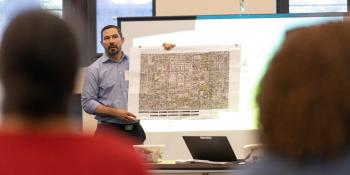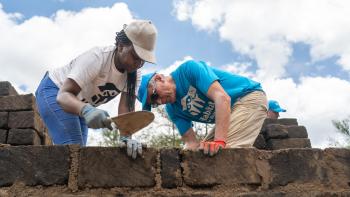
Building and beyond: 5 additional ways Habitat works to fulfill our mission
Most people know Habitat for Humanity as a global nonprofit that partners with families to build or improve decent, affordable places to call home. That’s at the very heart of what we do.
The need for global housing is so vast and the issues that surround it are so complex that we also work in many additional ways to partner with families and communities to create sustainable and sweeping change. That’s how we will realize our vision of a world where everyone has a decent place to live.
Learn more about just a few of these efforts:
1. Developing housing markets and microfinance
Habitat’s Terwilliger Center for Innovation in Shelter works to catalyze the private sector’s responses to the global need for affordable housing. Most of the world’s people build homes bit by bit as their families grow, as their limited finances allow and without access to the formal housing market. In response, Habitat works to expand innovative solutions, services and financing so low-income families can improve their shelter more effectively and efficiently.
Through ShelterTech, for example, the Terwilliger Center identifies and supports fresh ideas and start-ups working in the housing space. Participants receive access to expertise and catalytic funding to grow their businesses, plus the opportunity to grow their professional networks. Since the first accelerator, held in Mexico in 2017, ShelterTech has expanded to Kenya, India, Southeast Asia and the Andean region of South America.
Solutions have emerged from the program including sustainable waste processing for areas without sanitation services, 3D printing technology for home construction, a peer-to-peer lending platform for first-time homebuyers, and using augmented reality to connect families to designers and builders for remodeling and construction projects.
Through Habitat’s MicroBuild Fund, the Terwilliger Center also increases the availability and accessibility of housing microloans in 32 countries where financial institutions and services are limited. Microloans are different from traditional loans in that they have relatively short repayment periods, are for smaller amounts and require little or no collateral. In collaboration with financial partners, Habitat’s Terwilliger Center makes microloans available for families looking to expand or improve the quality of their homes, purchase land, or meet other housing-related needs.
2. Advocating for change
In addition to raising our hammers, Habitat also raises our voices through extensive advocacy efforts in the U.S. and around the world. These efforts seek to improve what might be less visible aspects of housing like laws, regulations, systems and policies that affect adequate and affordable housing.
Within the U.S., nearly 400 Habitat affiliates are leading the effort to eliminate barriers to decent housing as part of our national Cost of Home campaign. Working together over the five-year advocacy campaign, we aim to influence policies that will help 10 million individuals access an affordable place to call home. Now two years in, despite the ongoing housing challenges, significant progress has been made. From calling for increased investment in housing trust funds to championing mortgage relief for homeowners impacted by COVID-19 across all 50 states, advocates have used their voices to fight for solutions to address the housing needs in their communities.
Globally, we use our voices to engage at all levels of government, and, in partnership, we work in five key areas: ensuring access to adequate housing, improving housing finance options, strengthening land rights, enabling stakeholder engagement and creating resilient housing.
From strengthening women’s land rights in Zambia to encouraging the European Union to prioritize housing in its global development policies to calling on governments around the world to protect housing as a first line of defense during COVID-19, Habitat is committed to creating more equitable housing policies and systems to increase the scale at which we work.
3. Creating access to clean water and proper sanitation
Habitat helps families across the world improve their water, sanitation and hygiene systems, including during emergencies like disasters and COVID-19. We help residents install water kiosks in the heart of communities, creating access to clean water for washing, cooking and bathing. In addition to reducing health concerns posed by unsafe water, the kiosks also reduce the timely burden of fetching it, freeing residents from hours walking miles while carrying heavy loads of water, often from compromised open sources.
Every WASH initiative is developed to meet the needs of a given community. In Guatemala, where an estimated 85% of wastewater is left untreated and is often discarded into local water sources, Habitat Guatemala adds sanitary latrines to existing homes to reduce pollution and improve the health of families, farmlands and communities.
Habitat Cambodia staff and volunteers lead children through hygiene demonstrations to encourage improved practices. Habitat Macedonia has extended microloans to help hundreds of rural villagers eliminate their dependence on hazardously placed open wells and instead connect to their region’s safer central water system.
4. Equipping and empowering residents to create communities of opportunity
Habitat’s decades of work have shown us people thrive when they have a safe and stable home in a safe and stable community. For this reason, it is important to think about the whole neighborhood — not only the house — that Habitat homeowners and other residents will call home.
Through our neighborhood revitalization work, Habitat helps engage partner organizations and empower community leaders to respond to the needs and aspirations of their neighborhoods. By ceding the leadership role to residents, we can help ensure that this transformational effort will continue long after Habitat. To guide their efforts, residents use Habitat’s Quality of Life Framework, a data-driven and customizable approach to improving neighborhoods. This framework provides a road map for holistic change based on the unique gifts, dreams and concerns of each individual neighborhood.
For communities where safety is a priority, the framework helps residents set out steps to reduce the opportunity for crime — such as establishing after-school programs, improving lighting in public spaces or setting up a neighborhood watch. For a community in a food desert, the framework might lead them to set up a community garden or start a local farmer’s market to help them increase access to healthy food.
Whatever path they decide on together, through the bond of their shared neighborhood and the camaraderie and trainings offered by Habitat’s neighborhood revitalization work, community members have an increased capacity and motivation to overcome barriers to sustainable change.
5. Retrofitting existing shelter to meet changing needs
Rather than always starting new, Habitat has found that big changes in accessibility, affordability and safety can be accomplished through smaller cost-effective repairs and renovations that allow vulnerable homeowners to remain securely in their homes.
In the U.S., many older adults find their homes unsuitable for their needs or lack access to resources to make their homes livable and safe as they grow older. That’s why Habitat developed Housing Plus, a comprehensive aging in place strategy that uses a person-centered approach considering everything from lifestyle to type of home and allowing Habitat to address needs holistically.
In many parts of Eastern Europe and Central Asia, energy poverty — where residents either pay an exorbitant amount of their income to access utilities or are forced to go without — is a widespread issue that leaves those with the lowest incomes trapped in a perpetual cycle of poverty. But through the Residential Energy Efficiency in Low-Income Households project with USAID, Habitat is able to help families in Armenia, Bosnia and Herzegovina, and Macedonia make energy-efficient improvements that reduce their energy costs and improve their comfort and health.
In Guatemala, many families who have been excluded from basic services like electricity rely on indoor wood-fueled fires to prepare meals. The smoke from these fires lead to high rates of respiratory illness, especially among infants — which can prove fatal. Habitat Guatemala works with these families to install smokeless stoves, which eliminate indoor smoke and lower the risk of burns from cooking over an open flame.
They also cut the amount of wood needed to cook almost in half, saving families money and time. The stoves are often combined with a water filter and sanitary latrine to elevate the overall health of the home and the family inside. Families are involved in the entire process and learn how to assemble, use and maintain each product.
From investing in start-ups that disrupt the status quo to enacting policies that provide clear pathways to homeownership to partnering with families in new and exciting ways, Habitat can extend our reach and increase our capacity to help make sure that everyone has a safe, decent and affordable place to call home.

